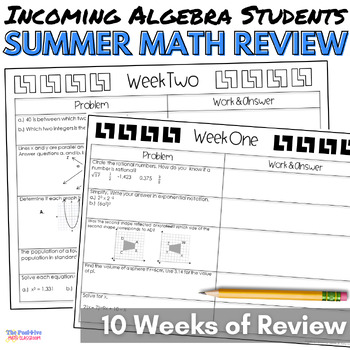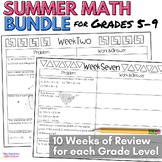Algebra Summer Math Review Packet
- PDF
What educators are saying
Also included in
- Avoid summer brain drain with these no prep math review calendars! In this bundle you will have access to 5 different math packets for students entering grades 5, 6, 7, 8, and Algebra 1 or freshman algebra. Each packet includes 10 weeks of problems that review the previous grade's math skills. NoPrice $24.00Original Price $30.00Save $6.00
Description
This summer math packet is a perfect way to help your students review material covered in 8th grade or pre-algebra. This printable set of worksheets in the form of a 10 week calendar is meant for students entering Algebra 1 and can be used as a tutoring tool, a summer assignment, or a back to school review. Best of all, the calendar is easy to use while being an effective way for keeping skills sharp.
The calendar provides a variety of math topics aligned to the 8th Grade Common Core Standards to keep your students’ minds in the math mode.
Topics include:
- Exponential Notation
- Equations
- Graphing
- Systems of Equations
- Functions
- Volume Problems
- Scatter Plots (and more!)
Looking to purchase summer math review for more than one grade? Save money and purchase this Algebra 1 math review calendar as part of a bundle here: Summer Math Calendar Bundle: Grades 5-Algebra 1
Included with your purchase:
- A Cover Page for the Math Calendar
- Introduction letter to parents and students
- List of math topics and Common Core standards that are covered
- Surveys for students and parents to provide feedback of the work
- 10 Weeks of math problems
- Answer Key for each week
- Summer Math Quiz and answer key
Check out what other teachers are saying about this summer math calendar:
"Such a great resource... Only wished I found it sooner! I will definitely be using it at the end of the school year!"
"I purchased this for my daughter to work on this summer. Complete review- thank you!"
"I had my advanced kids do this packet over the summer. Great resource!"
"These were great for me to use with a student I am tutoring over the summer."
Click here to follow me for more math resources that are always 50% off for the first 24 hours!






